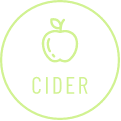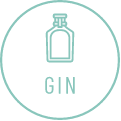
The BIG Pick
The Courtney’s of Whimple ‘Cider Orchard’ is open for one weekend in September. Apple picking, pressing, music and much more
Tell me moreCourtney's 'Silly Cow' Cider Wins Best Medium Cider Award
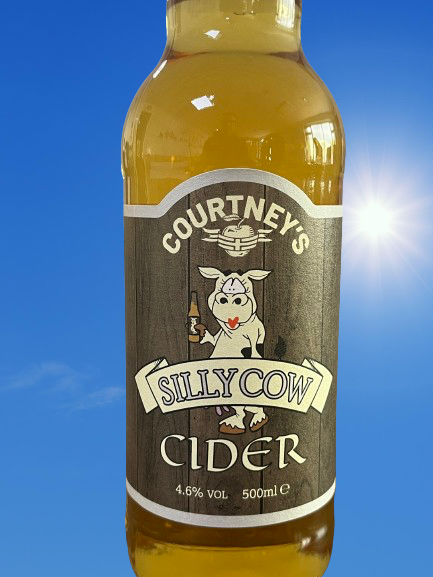
We are thrilled to announce that our 'Silly Cow Cider' has won the 'Best Medium Cider' category at the recent South West of England Cidermakers' Association (SWECA) annual cider competition. Our flagship traditional cider took the top award last month in the largest of categories to give the team an early boost at the start of the 2025 season.
Courtney's range of traditional ciders are made with 100% apples from our 100-year-old ancient cider orchard in Whimple (Devon) with as little human intervention as possible. They are naturally fermented using only the natural yeasts on the apple skins, ensuring a truly authentic and delicious flavour. Gluten, vegan and vegetarian friendly too.
You can enjoy our award-winning Silly Cow cider in bottles, pouches, bag-in-boxes and it is also available in kegs for the trade. Check out our full range of traditional ciders in various formats 'HERE'.
A huge thank you to our amazing team and loyal customers for your continued support. This achievement wouldn't have been possible without you. Cheers to many more delicious moments ahead!
The Big Pick 2025. Orchard Days - Apple Picking, Pressing, Cider and Music
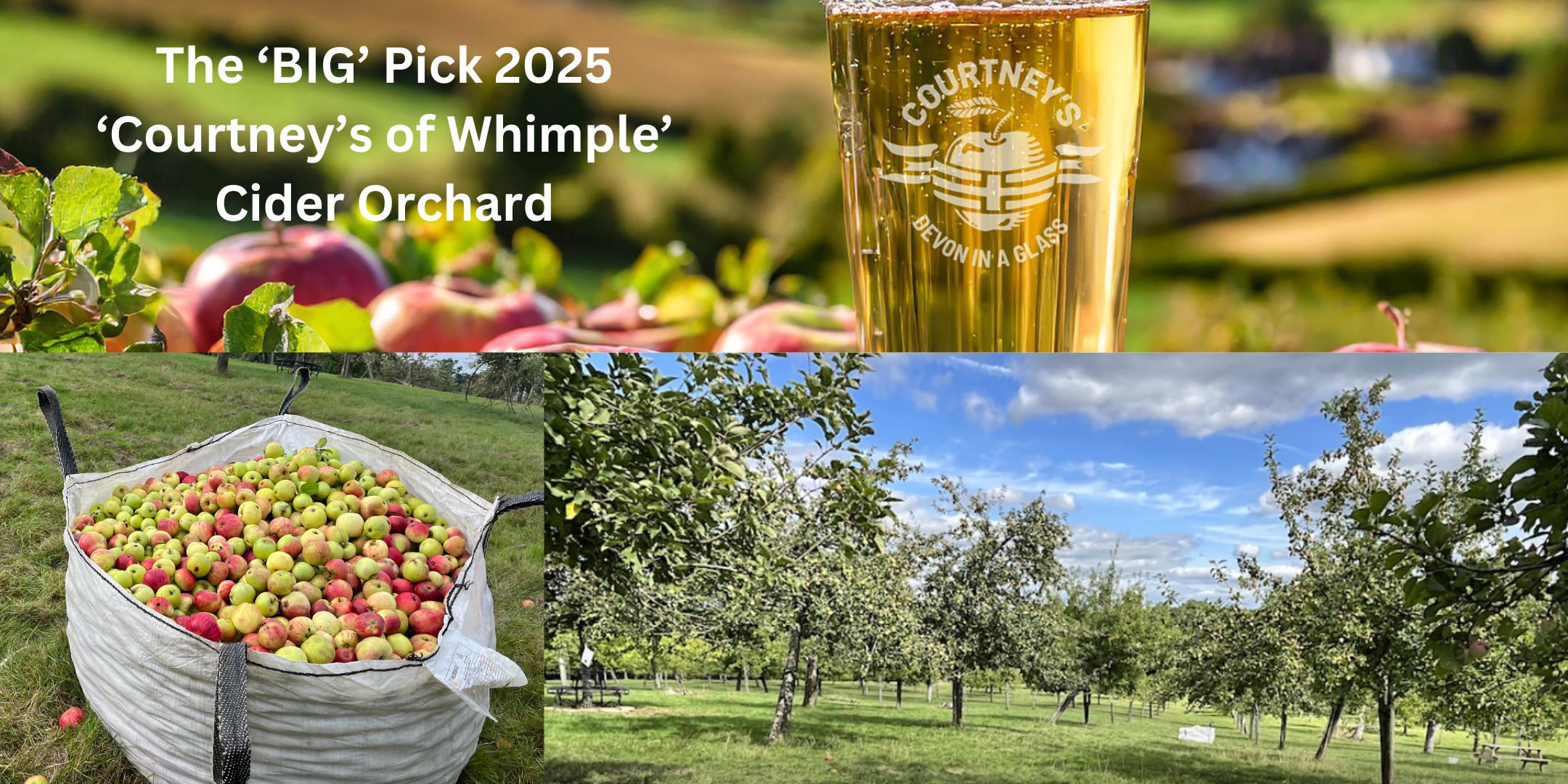
The 2025 'Open Orchard' weekend - part of the Taste East Devon Festival.
Saturday 20th September - 11am to 5pm
Sunday 21st September - 11am to 5pm
Purchase your tickets HERE.
Join us at the enchanting 'Courtney's of Whimple' cider orchard, nestled off Southbrook Lane in Whimple, Devon. This ancient orchard, with trees over 100 years old, will be open to the public for a weekend of exploration, live music, and relaxation with family and friends.
Experience the Magic of Cider Making:
Harvest Cider Apples: Participate in this year's cider apple harvest and be part of the Courtney's cider-making tradition.
Press Your Own Apples: Use our apple crushing and pressing equipment to turn apples you collect from the orchard into fresh, natural apple juice (up to 10kgs per person). Alternatively, bring your own apples, and we'll press them for you to take home. It doesn't get fresher than that!
Why Visit?
Historic Orchard: Wander through one of East Devon's oldest orchards, part of the original 'Whiteways of Whimple' orchards.
Live Entertainment: Enjoy live music as you soak in the serene atmosphere (line up still being finalised).
Family Fun: A perfect outing for families and friends to create lasting memories.
Don't miss this unique opportunity to immerse yourself in the rich heritage and vibrant community spirit of East Devon.

WHAT'S ON OVER THE WEEKEND (still being finalised)
Apple Picking: Dive into the Courtney's cider-making tradition by helping to harvest this year’s apple crop. Wander through our ancient East Devon orchards and soak in nature at its finest.
Apple Pressing: Create your own fresh juice by pressing apples you bring or those you pick from the orchard. Note: £2 per kg charge applies. Bring your own vessels for juice or we can provide them free of charge.
Stalls: Explore a variety of gifts and produce from local small business entrepreneurs.
Live Music: Enjoy live music all weekend long. Details still being finalised.
Bar: Savour the Courtney's Drinks range, including cocktails, our award-winning traditional, fruit, cloudy, low-alcohol ciders, and soft drinks from our cider bar.
Refreshments: Hot and cold refreshments will be available all day.
A RELAXING DAY: Grab a cider, some tasty food, and relax in the beautiful East Devon countryside. Enjoy our apple picking and pressing experience with live music.
All in all, it's a cracking day out for everyone in the fresh air at a local family business in East Devon. Not to be missed!
TICKETS
Day Tickets: Adults £6 per person, Under 16s £1.
'FLEXIBLE' Weekend Pass: Adults £8 per person, Under 16s £1.50.
Purchase your tickets on Eventbrite HERE
(Note: tickets are non-refundable, Under 2s FREE)
OTHER BITS
Well behaved dogs are permitted. We just request that they remain on a lead as we have sheep grazing in the orchards.
Limited parking facilities (we would encourage those that are close to walk or cycle, if possible).
We keep beehives in the orchard to pollinate our trees. Please keep a reasonable distance away from them as they are very busy bees!
HOW TO FIND US
Courtney's Orchards, The Old Orchards, Southbrook Lane, Whimple, EX5 2PD
View on Google Maps: HERE
Your Sat Nav may take you to a neighbouring farm. Our orchard is on 'Southbrook Lane' just past the railway bridge. 1 mile from the old A30.
what3words: themes.extreme.flattered
A short walk or cycle from Cranbrook, Whimple, Broadclyst and Rockbeare.
ABOUT COURTNEY'S DRINKS
We create our range of award winning ciders and juices from the apples in our orchard. Everything is done naturally with as little human intervention as possible. We hand pick, press and bottle within the orchard. We don't use harmful chemicals or fertilisers, just let nature do what it does best. Our range of ciders available include traditional, fruit and low alcohol. We also produce THE EXE GIN and Grumblebee Honey Spiced Rum which will be available to try and / or take away.
Whimple Orchards (GOLD winner) and Silly Cow Cider (SILVER winner) at the 2024 Japan Cider Cup. Yep - we export our Whimple cider to Japan!
Full range of Courtney's Drinks HERE.
{photos shown from previous events}
Join us at Exmouth's Christmas Market - 13th to 17th December 2024

Get ready for a festive treat and join Courtney's Drinks at the Exmouth Indoor Christmas Market from December 13th to 17th. This is the perfect opportunity to experience our delightful array of gift ideas and indulge in some holiday cheer. Yes we will have samples too!
We'll be showcasing our finest tipples, perfect for Xmas gifts or enjoying at your own festive gatherings. Whether you're looking for a unique present for a loved one or simply want to stock up on your favourite drinks, our stall is a must-visit.
But that's not all! The Exmouth Christmas Market is full festive goodies, featuring over 80 local traders offering a wide variety of Christmas gift ideas. From handcrafted ornaments to delicious treats, there's something for everyone. It's the ideal place to find those special, one-of-a-kind gifts that will make your holiday season truly magical. And the good bit - you'll be supporting hard working, local businesses all under one 'marquee' roof top!
Make sure to put these dates in your calendar and plan a visit to the Exmouth Christmas Market. With so many wonderful stalls to explore, including Courtney's Drinks, it's an event you won't want to miss. Bring your friends and family, soak in the festive atmosphere, and enjoy a memorable shopping experience. See you there!
The Big Pick 2024: Open Orchard Days - Apple Picking, Pressing, Cider and Music
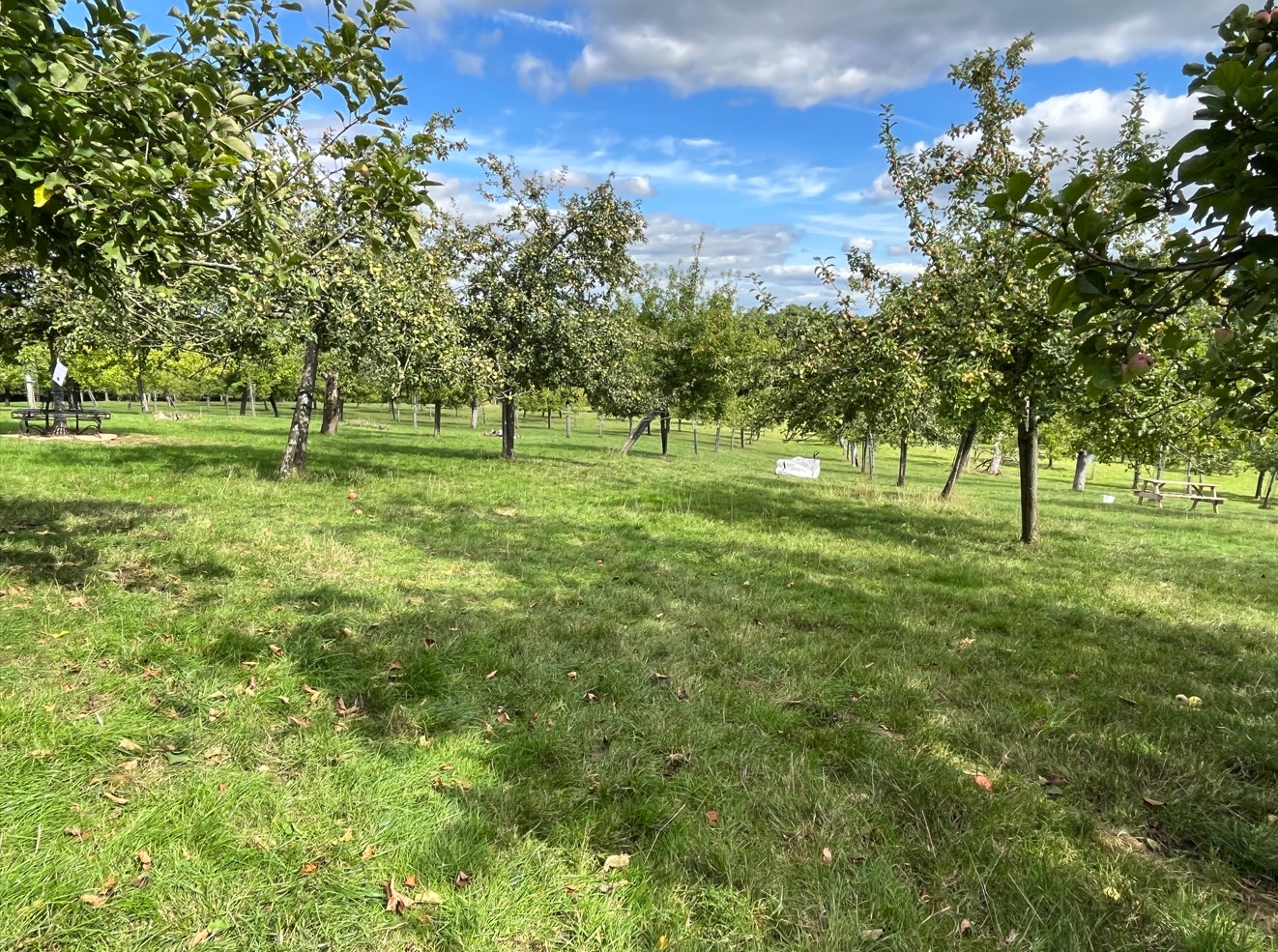
BACK FOR 2024 - part of the 9 day Taste East Devon Festival
Saturday 21st September - 11am to 5pm
Sunday 22nd September - 11am to 5pm
Purchase your tickets HERE
The 'Courtney's of Whimple' stunning, ancient cider orchard off Southbrook Lane, Whimple, Devon will be open to the public for the weekend for all to explore, be entertained by live music and to relax with family and friends.
Be part of the Courtneys cider making experience by helping with this year's harvest of cider apples. There is also the opportunity to press apples you have collected from the orchard with our apple crushing and pressing equipment to have your own natural apple juice to take away (max 10kgs per person). Alternatively, bring your own apples and we'll press them for you to take home. It doesn't get fresher than that!
Let time pass you by in one of East Devon's oldest orchards - one of the 'original' Whiteways of Whimple orchards. Some trees are over 100 years old and still producing a fabulous crop!
WHAT'S ON OVER THE WEEKEND
Apple Picking - Be part of the Courtneys Cider making experience by helping to harvest this year’s apple crop. Explore and relax in our ancient East Devon orchards, experiencing nature at its finest.
Apple Pressing - The opportunity to press apples you have brought with you to create your own fresh juice or press the apples you have picked from the orchard (note: charge £2 per kg - either bring your own vessels for juice or we can provide free of charge).
Live Music - will be played from the Orchard at various times on both days. We are just finalising our line up which will be updated here soon.
Bar - Experience the Courtney's Drinks range including cocktails, our prize-winning traditional, cloudy, low-alcohol ciders and soft drinks from our cider bar.
Refreshments - Hot and cold refreshments will be available all day including a pizza van (new for 2024).
Stalls - Local small business entrepreneurs will be onsite offering a varied selection of gifts and produce for all to enjoy.
A RELAXING DAY
Grab a cider, some tasty food, throw down a blanket and relax in the beautiful East Devon countryside and enjoy our picking and pressing experience with live music.
All in all - a cracking day out for all in the fresh air at a local family business in East Devon.
TICKETS
Day Tickets: Adults £6 per person, Under 16s £1.
'NEW' Weekend Pass: Adults £8 per person, Under 16s £1.50.
Purchase your tickets on Eventbrite HERE
(Note: tickets are non-refundable, Under 2s FREE)
OTHER BITS
Well behaved dogs are permitted. We just request that they remain on a lead as we have sheep grazing in the orchards.
Limited parking facilities (we would encourage those that are close to walk or cycle, if possible).
We keep beehives in the orchard to pollinate our trees. Please keep a reasonable distance away from them as they are very busy bees!
HOW TO FIND US
Courtney's Orchards, The Old Orchards, Southbrook Lane, Whimple, EX5 2PD
View on Google Maps: Here
Your Sat Nav may take you to a neighbouring farm. Our orchard is on 'Southbrook Lane' just past the railway bridge. 1 mile from the old A30.
what3words: themes.extreme.flattered.
A short walk or cycle from Cranbrook, Whimple, Broadclyst and Rockbeare.
ABOUT COURTNEY'S DRINKS
We create our range of award winning ciders and juices from the apples in our orchard. Everything is done naturally with as little human intervention as possible. We hand pick, press and bottle within the orchard. We don't use harmful chemicals or fertilisers, just let nature do what it does best. Our range of ciders available include traditional, fruit and low alcohol. We also produce THE EXE GIN and Grumblebee Honey Spiced Rum which will be available to try and / or take away.
Whimple Orchards (GOLD winner) and Silly Cow Cider (SILVER winner) at the 2024 Japan Cider Cup. Yep - we export our Whimple cider to Japan!
Full range of Courtney's Drinks HERE.
{photos shown from previous events}
Ultimate Chocolate Orange Cake
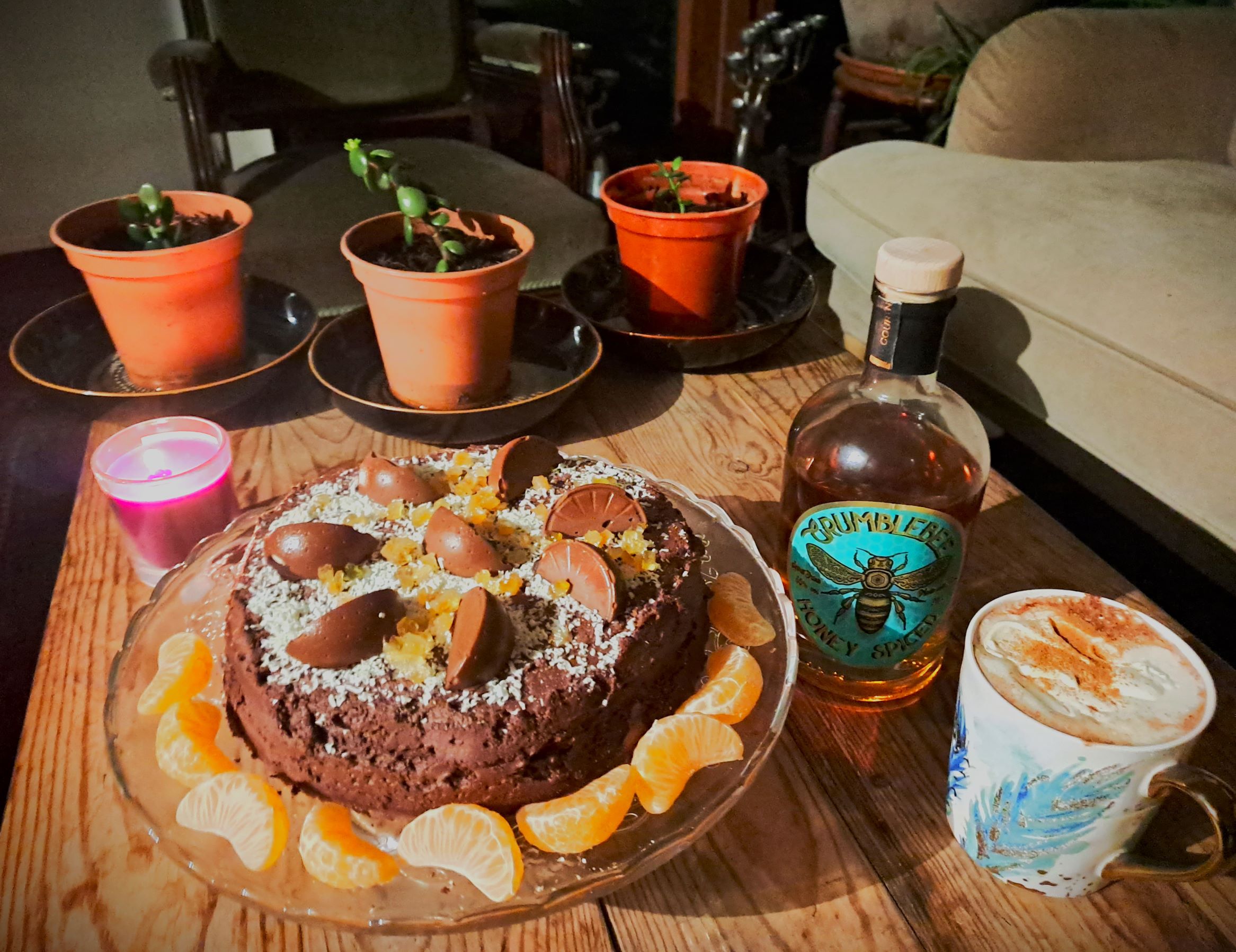
I’m not going to give much preamble for this, since it’s a bit of a mammoth recipe, but definitely worth it, if you’re a fan of chocolate orange. All I am going to say is: take a deep breath; take one step at a time; and remember that it will all be worth it in the end… also, please ignore my appalling decorating skills. As my sister always points out, it’s just going to get eaten, anyway!
Chocolate Orange Cake
Ingredients
- 1 medium orange
- 175g soft margarine
- 175g sugar
- 3 eggs
- 2 tbsp cocoa powder
- 2 tbsp warm water
- 1 tsp baking powder
- 200g wholemeal flour (or plain flour with 1 tsp bran flakes)
- 5 tbsp plain natural yoghurt
Method
- Preheat the oven to 170°C and grease an 8” cake tin, lining the bottom.
- Grate the rind of the orange and juice it, keeping the rind and juice separate.
- Beat the margarine until it is soft and smooth, before adding the sugar and orange rind and continue beating until it is light and fluffy.
- Crack the eggs into a small bowl and lightly beat. Add the beaten eggs into the margarine mixture a little at a time, beating well between each addition.
- Put the cocoa powder and warm water into a small bowl and stir it to make a smooth paste. Then, add the cocoa powder mixture to the margarine and stir it in
- Sift together the flour and baking powder (be sure to add and trapped bran flakes back in) and add half to the mixture. Add half of the yoghurt and gently fold the ingredients together. Repeat the process with the other half of the ingredients.
- Add in the orange juice and fold it in.
- Pour the batter into the cake tin and bake for 1 hour. If the cake does not feel firm at this point, put it back in the oven until it is firm. If it is baked, remove it from the oven and allow to cool completely before removing it from the tin.
Marmalade glaze
Ingredients
- Marmalade
- 240g dark chocolate
- 150ml plain natural yoghurt
Method
- Heat approximately 2 tbsp of marmalade in a small pan over a low heat, stirring constantly. When the marmalade is fully melted, place it through a sieve to remove any peel.
- Spread the glaze over the top of the cake, making sure that it does not run down the sides.
Note: this part is subjective. I’ve been told that I have a tendency to turn things into Jaffa Cakes, which for some reason is not always appreciated, hence the 2 tbsp limit, and there are people in my life who do not like chunky marmalade (I know that they are heathens, but they are not to be reasoned with). My point is that you can tailor this step to your own tastes. If you just want a mild glaze, then 1 tbsp might suit you better… or you can follow my example and melt an entire jar and just slather it on!
Chocolate Topping
Ingredients
Method
- Melt the chocolate in a double boiler (a pan of boiling water with a heatproof bowl over it).
- When the chocolate is melted, remove it from the heat and whisk in the yoghurt.
- When it is cool, spread it over the cake.
Note: the yoghurt cools this mixture very quickly and you can’t let it get too hard otherwise it will be difficult to spread, as the photo of my cake proves!
Orange Mousse Chocolates
Ingredients
- 1 medium orange, juiced and zested
- 2 eggs, beaten
- 2oz butter
- 75g sugar
- 150ml double cream
- 1 tbsp sugar
- 1 tsp orange essence
- 1 tbsp condensed milk
- 200g orange chocolate, or as needed
Method
- Make an orange curd: place the juice of 1 medium orange, the butter and sugar in a double boiler and heat until melted. When they have melted and combined, reduce the heat to low and start slowly adding the eggs, stirring constantly. Keep stirring until the custard has thickened. Remove from the heat and put aside to cool completely.
- Whip the cream and 1 tbsp sugar to soft peaks (about 50%) and add in all the curd, the essence and the condensed milk. Whisk until thick and holding its own shape.
- Set aside.
- Melt the orange chocolate of your choice. There are different tempering techniques depending on if you are using white, milk or dark chocolate, so if you want to check that out, I’m going to have to suggest you look up better instructions than I can offer for your specific chocolate type.
- Fill chocolate moulds with the melted chocolate (bonus points if they are in the shape of citrus segments), make sure all the sides are covered and then tip all the chocolate you can back into the bowl, leaving you with space to put your filling. Clean off the top of the mould to try and stop them all sticking together.
- Once the moulds are set, fill a piping bag with your ‘mousse’ and fill the moulds, being sure not to fill them all the way, or sealing them off will be difficult.
- Put the filled moulds in the freezer for 20 minutes, as this will make sealing them a lot easier.
- Remelt your remaining chocolate and cover the openings, sealing in your chocolates.
- Refrigerate until solid and then remove them from the moulds.
Decorating
Finely grate white chocolate over the top of the cake. Arrange the filled chocolates decoratively. Scatter candied orange peel for some colour. If you have any of the chocolate orange left, rather than throwing it away, fill moulds with it completely and add to the decorations! Go wild!
Serve with
Rum spiked orange and cinnamon hot chocolate.
- 80g Dark Chocolate
- 1 medium orange (zest of the whole orange and juice of half)
- 1 cinnamon stick
- 400ml milk
- Grumblebee Honey Spiced Rum to taste (at least 1 tbsp) https://courtneys.online/rum/grumblebee-honey-spiced-rum-70cl/
- Double cream
- 1 pinch powdered cinnamon
Method
- Gently heat the milk over a low heat and add the orange zest and cinnamon stick. Stir continuously to prevent the milk from burning. Simmer for a minute to let the oils infuse.
- Remove the cinnamon stick and add the chopped up dark chocolate. When the chocolate is completely melted, add the orange juice.
- Add the rum and increase the heat to medium, stirring until the mixture is bubbling. Remove immediately.
- Serve with soft whipped cream sprinkled with powdered cinnamon.
Bacon, Brie and Chutney Sandwich
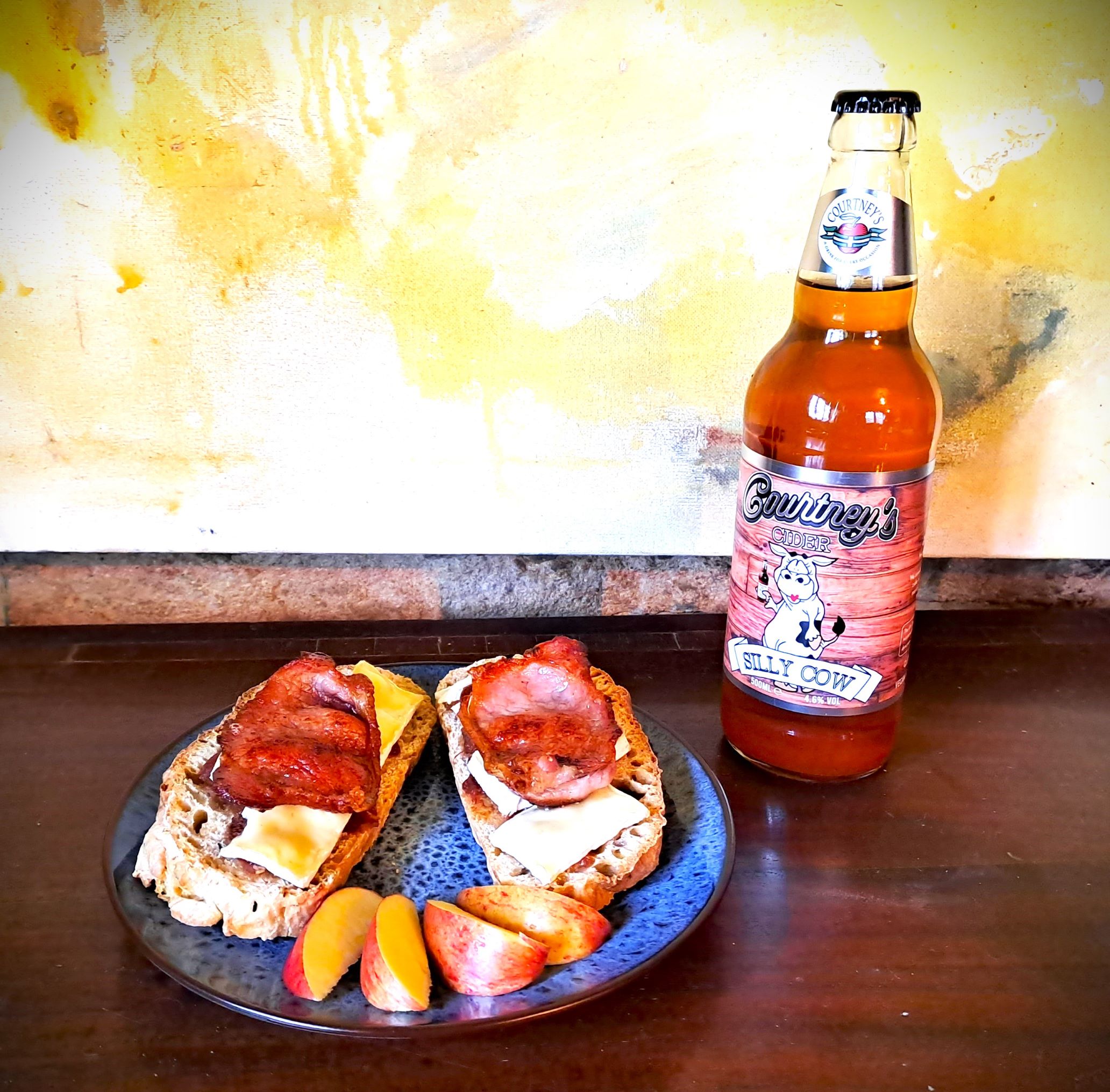
This is exactly what it sounds like: simple and delicious.
Take two slices of your favourite bread (if you’re looking for a pretty fab, Courtney’s approved recipe, then see our no-knead air fryer cider bread) and toast them lightly. Preheat the oven to 180°C. Spread a layer of apple chutney on each piece of toast and then cover thin slices of brie over the entirety of the toast. Place in the oven for 10 minutes, or until the brie is melted.
In the meantime, fry your bacon. 2-4 slices, depending on how indulgent you are being.
Remove the slices of toast from the oven, lay the bacon on each slice (1-2 pieces) and either pile everything up into a sandwich, or eat open-faced. I, personally, always find that my sandwich fillings like to escape, so tend to eat them open-faced.
Now, since that is all obviously far too easy, here’s an apple chutney recipe, just to make things complicated… just in case you like planning your sandwiches 6 months in advance!
Recipes will be divided on the type of apples you should use. If you have an apple tree, use your own fruit. If you have apples you haven’t eaten, use those. Cooking apples ‘fall’ and your chutney will be more pulpy. Eating apples will, sometimes, retain more of their integrity and give your chutney more texture. It’s your preference. Whatever you use, please leave the chutney to mature – minimum 3 months and better the nearer to 6. If you take the lid off new chutney and smell vinegar, put the lid back on, sigh deeply and wait for another few weeks: it will be worth it.
Remember to sterilise your jars ahead of making the chutney. Wash the jars and lids, and put into a pre-heated oven @ around 120 degrees. 15 minutes should be enough. The jars should be cooled by the time you are filling them (easier to handle).
Ingredients: per pint of chutney (scale up if you have more apples)
- A generous pound of apples (500g)
- 1 medium (on the large side of medium) onion
- 375g dark soft brown sugar
- 250g of dried fruit (recipes state raisins, but mixing raisins with chopped prunes or figs adds a different depth – depends what you have open in your cupboard)
- 2tsp of mustard or onion seeds (or a mixture of the two)
- 1 tsp of ginger or mixed spice
- 1 tsp salt
- 350ml cider vinegar (the cider vinegar does make a worthwhile difference)
Method
- Peel and chop the apples into small pieces.
- Peel and chop the onion finely (do not use a food processor)
- Put all the ingredients into a heavy bottomed, large pan.
- Bring to the boil and then turn the heat down and simmer (with a lid) for about 15 minutes, or until the apples are soft.
- Take the lid off and simmer uncovered to evaporate most of the liquid. Stir occasionally to check nothing is sticking to the base.
- When you can draw a wooden spoon across the chutney surface, and the motion leaves a shallow trench, remove the chutney from the heat.
- Let it rest and cool a little.
- Ladle into your sterilised jars while the chutney is still hot, and seal. Store in a cool, dark cupboard. Once open, refrigerate.
Serving Suggestion
Silly Cow Cider https://courtneys.online/cider/silly-cow-cider/
'Tis the Season to Plan
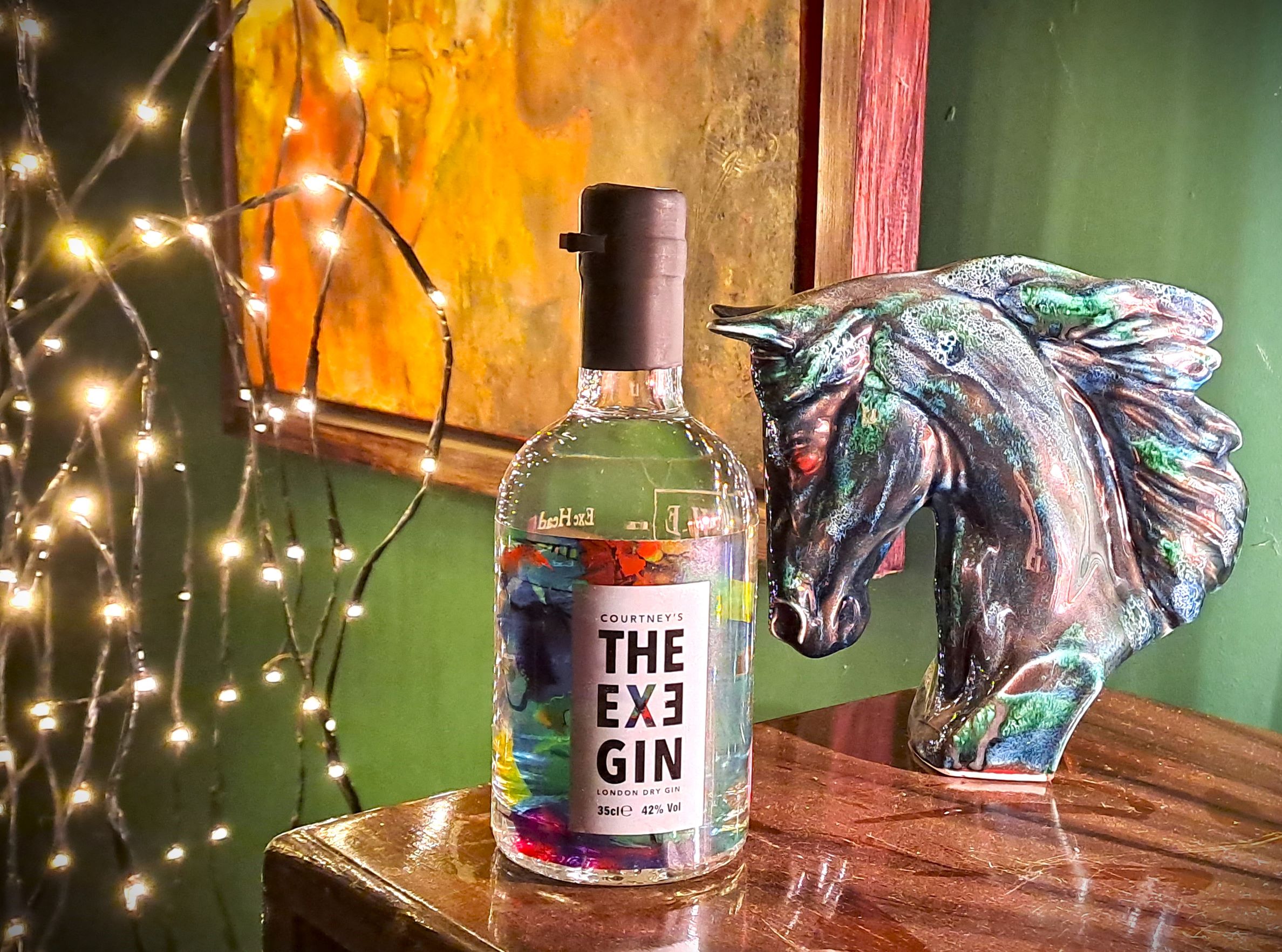
Or over-planning, really.
I don’t know what happened, but one moment I ask the innocent question of what everyone had any ideas for Christmas treats and suddenly I have a list as long as my arm! It’s fantastic. I will never, ever get round to making it all, but I can dream.
So far, for Christmas day, there is a mincemeat crumble; a chocolate and mint Boston Cream Pie (my personal favourite); of course, since there will be egg whites left from the crème légère, some meringues are de rigeure; cinnamon buns for breakfast and homemade sausage rolls for lunch.
And then there are indulgences for throughout December.
Minced Pies, of course! Lots and lots. The minced meat is fully stocked and a battle plan has been drawn up to get through it all.
Baked apple truffles (not sure these will work, but excited to try them out)
Yorkshire puddings with spiced vegetable stew… I haven’t had it in ages, but it’s a family favourite and I don’t know why we don’t do it more often.
Great-great-grandmother’s ginger biscuits that can only be made in December and the rest of the year talked of in hushed and reverent whispers. It’s the only recipe I will never give up the secret to and the day I was allowed to write it in my recipe book will forever live in my memory.
Caramels
3 types of fudge (vanilla, chocolate mint, and hazelnut). More were about to be added, but I had to put my feet down.
‘Beethoven chocolates’. I don’t know if anyone else does this. They’re little balls of marzipan, with chopped up rum-soaked apricots in the middle of them and a toasted almond on top, covered with chocolate, so kind of like a homemade Mozart chocolate, but with some extra frills… not that Beethoven is especially frilly, but his name seems to have become affixed to these magnificent monstrosities in this household. My mum’s been talking about them since August.
A list of new carrot recipes, about six so far.
Cinnamon and ginger cake, obviously.
Star anise ice cream with candied orange peel. It tastes like being round a Christmas smells when you’re about 5. I swear, it makes the room glow when you eat it. Pure excellence but rather dividing (pretty much exactly 50-50), so I get to eat it into the new year!!!
More is being added to the list daily and I swear I will be put into a sugar coma just by reading it. So, if you need to find me in the next month, I will be passed out in a bowl of chocolate, very happy and very hyped up.
Pub Quiz 7
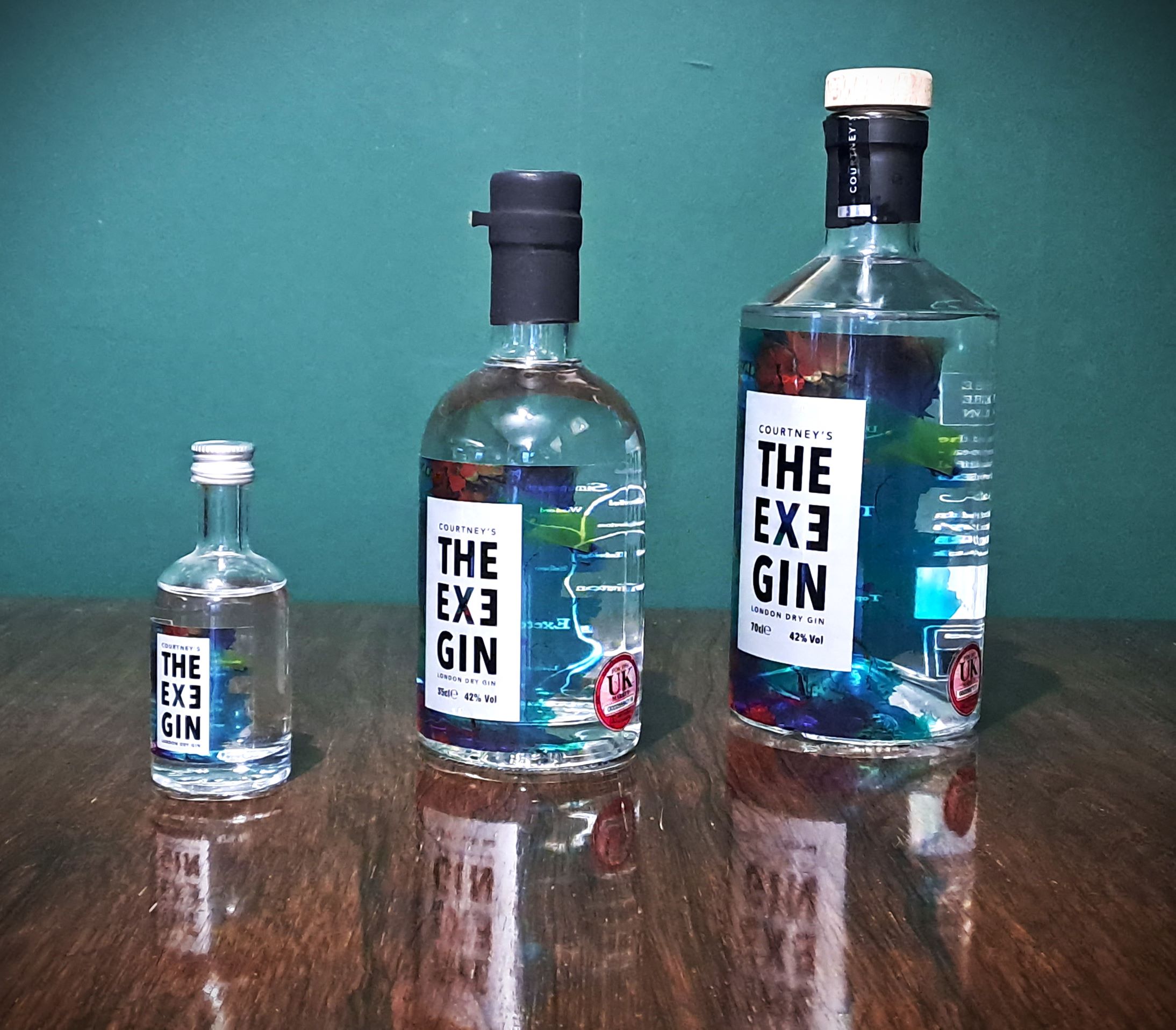
- What flower are apples related to?
- Lilacs
- Magnolias
- Daisy
- Rose
- In 1664 John Evelyn wrote about the health benefits of drinking cider. Which of these did he NOT claim cider could do?
- Aid digestion
- Cleanses the stomach
- Strengthen the heart
- Prevents kidney stones
- What common word comes from the drinking of rum?
- Jingled
- Groggy
- Symposium
- Glorious
- Apart from juniper berries, what is the plant most often used in gin?
- Coriander
- Cumin
- Cardamon
- Cicely
(Answer: d) Rose. Apples are related to roses.)
(Answer: c) Strengthens the heart. John Evelyn said that ‘Generally all strong and pleasant cider excites and cleanses the Stomach, strengthens Digestion, and infallibly frees the Kidneys and Bladder from breeding the Gravel Stone’)
(Answer: b) Groggy. In the 18th and 19th centuries, grog was served on naval vessels to combat drunkenness (grog is rum mixed with water, lemon juice and sugar) but many sailors saved up their rations and got drunk on it and ended up feeling the effects of ‘grogginess’ the next day.
Jingled is an American term to describe being mildly drunk
Symposium comes from the Greek word meaning to drink together, or have a drinking party.
Glorious can be used to describe the funny stage of drunkenness. It is not a quantitative measure of drunkenness, but a qualitative one.)
(Answer: a) Coriander)
Apple Sharlotka Cake
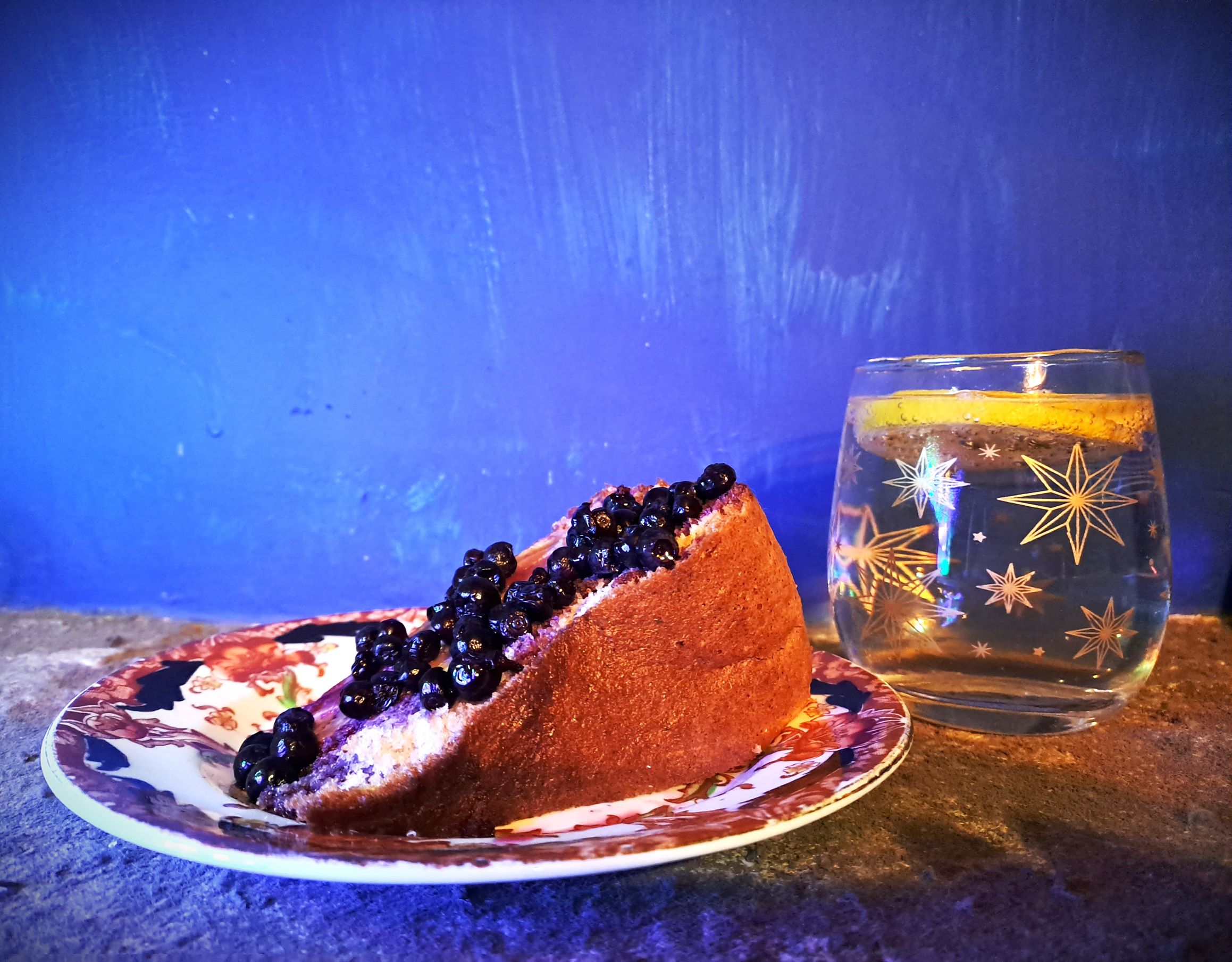
This is essentially an Apple Genoise, which sounds really complicated, but is actually one of the easiest cakes to make, in my opinion/experience. The only thing you have to do is make sure that you prep everything ahead and take the time to get lots of air into your batter. If you do that, you will be left with a light and fluffy, heavenly textured apple cake.
First off, I’ll give you my great-gran’s tip for a guaranteed light sponge: sieve the flour three times. It sounds like a gimmick, but it makes a huge difference. If you want to guarantee a perfectly light cake, take the extra 60 seconds and sift away! This isn’t just for Genoises (I don’t think she had much truck with ‘fancy’ cakes like that) but it makes it is also an indispensable tip for Victoria sponges and Yorkshire puddings. Get the air into the flour and 50% of your work is done for you.
My other tip is to work fast. You have to take 6 minutes to whisk your eggs with an electric whisk (apparently 8 minutes with a stand mixer, but I’ve never tried that), again to get the air in, and as soon as that is done be sure to get your dry ingredients and apples in quickly and get that cake straight in the oven. Sugar reacts with egg yolks and if you leave the egg/sugar mixture standing there while you get other ingredients sorted out, you’re going to end up with a tough cake. Pre-prepare your ingredients!
Anyway, enough with my rambling, here’s the recipe:
- 6 eggs
- 200g granulated sugar
- 150g flour
- 1/2 tsp baking powder
- 1 tsp vanilla extract
- 1 tbsp melted butter or neutral oil
- 680g sour apples (e.g. Granny Smith or Braeburn)
- Preheat Oven to 180°C. Line bottom of un-greased 9” springform tin with a ring of baking paper.
- Peel, core, chop and thinly slice your apples. Cover with a tea towel to prevent them from discolouring and set aside.
- Add 6 eggs to the bowl and whisk for 3 minutes on high speed. Keep whisking for another 3 minutes on high speed, slowly adding in the sugar. This might sound like a faff, but I promise, it works every time.
- Add the flour and baking powder mixture into the beaten egg batter in 3 increments, folding between each addition. Scrape from the bottom of the bowl to ensure pockets of flour aren't missed (they hide). Make sure everything is incorporated, but don’t over-mix! Quickly fold in the vanilla extract and butter just until incorporated.
- Fold in sliced apples, reserving 1 couple of handfuls for the top. Fold just until combined into the batter then pour batter into prepared tin. Spread batter evenly with a spatula (do not tap the pan) and scatter the remaining apple evenly over the top. Bake at 180˚C for 50-55 minutes. The top will be golden brown.
- Remove from oven and rest in tin 15 min. Slide a thin spatula or knife around the edges of the pan to loosen then transfer to a cake platter to cool to room temperature.
Serving Suggestion
Serve with Gin and Tonic.
https://courtneys.online/gin/the-exe-gin/
This cake is pictured with preserved bilberries, but raspberries and blueberries work very well too.
Pumpkin Tempura
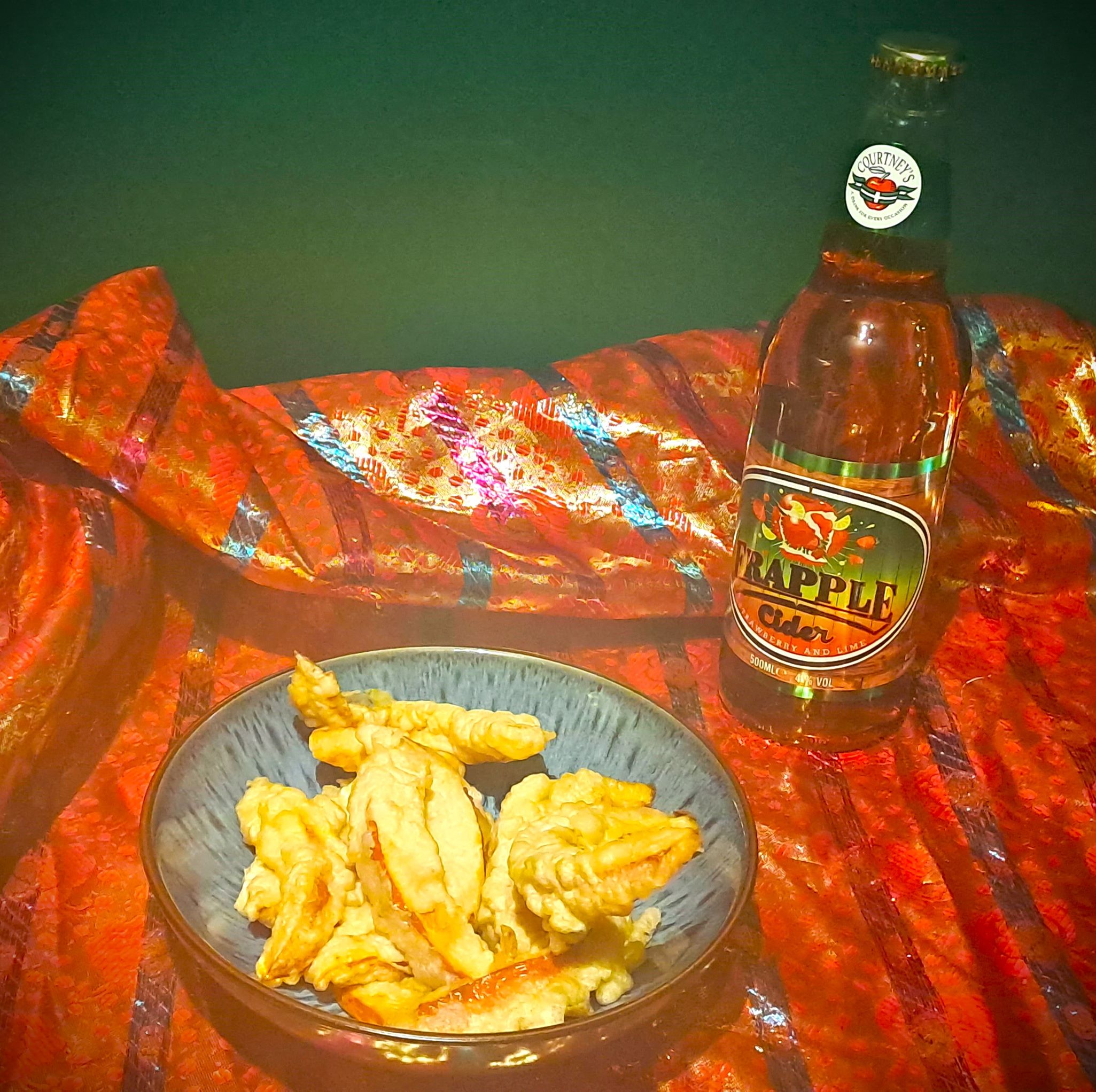
This is a Japanese snack and really, truly, utterly delicious.
I’m a big fan of pumpkin, but do sometimes find it takes a lot of time to deal with, when you’ve got to roast it off, let it cool remove the flesh, etc. etc. So, imagine my delight when I found a recipe for pumpkin that’s done in 4 minutes, is comfort food and tastes like the best aspects of pumpkin, paired with the best things about sweet potato fries!
To be honest, I’m a bit in love.
My only warning about this recipe is that these things are FILLING. I only made half a Hokkaido Pumpkin’s worth of these babies, but it still took me three days to finish them (they reheat really well in the oven or air fryer), because my goodness do they fill you up.
They can be eaten on their own, or dipped in soup, or (if you’re going non-vegan) into runny egg yolk, which is my new dream lunch. Actually… they really go with everything.
- 1 small pumpkin, like a Kabocha or Hokkaido
- 90g flour
- 30g additional starch (potato starch, cornflour or arrowroot (p.s. arrowroot is gluten free and low carb and behaves exactly like cornflour)
- 230ml sparkling water, slightly frozen (put it in the freezer an hour before you need to use it)
- Neutral oil (for frying)
- Salt, to taste
- Wash your pumpkin, cut it in half, scoop out the guts and slice into ½-1cm slices. Leave the skin intact.
- Mix together the flour, starch and sparkling water until smooth.
- Dredge the pumpkin slices in the batter.
- Heat 2cm of oil to 180°C and add pumpkin slices. Don’t add too many at once, or your oil will cool down too much. Somewhere between 4-6 slices, depending on the size of your pan.
- Cook pumpkin for 4 minutes, until golden and crispy.
- Remove, drain and sprinkle with salt.
Serving suggestions
Strawberry and Lime Frapple goes so well with tempura!
https://courtneys.online/cider/frapple-strawberry-and-lime/


